Is Earth’s Population Much Higher Than We Think?

© Ingo Joseph / Pexels
For years, the official estimate of Earth’s population has hovered around 8.2 billion.
However, a new study suggests that the actual number of people living on our planet could be much higher.
Additionally, if true, this revelation could have significant implications for everything from resource management to global policies. Let’s break down the findings.
Researchers Believe We May Be Undercounting Our Population
A team of scientists has questioned the accuracy of current population estimates, arguing that many factors could be causing a significant undercount. The study suggests that census data, which forms the basis for global figures, may not fully account for undocumented populations, transient groups, and communities in remote or conflict-ridden areas.
Where Are the “Extra” People?
The researchers point to several regions where population undercounts are likely to occur:
- Rural and Isolated Areas – In some parts of the world, especially in Africa, Asia, and South America, census-taking is difficult due to geography and lack of infrastructure.
- Refugee and Migrant Populations – People displaced by war, climate change, or economic hardship may not be included in official records.
- Off-the-Grid Communities – Certain groups, such as nomadic tribes and people living in informal settlements, may not be counted in traditional censuses.

Why Does This Matter?
If the global population is significantly higher than current estimates, it could have major consequences:
- Resource Distribution – Governments and organizations rely on population data to allocate food, water, and medical supplies. An undercount could mean that aid isn’t reaching everyone who needs it.
- Urban Planning and Infrastructure – Cities base their development plans on population figures. If the numbers are off, it could lead to overcrowding and insufficient public services.
- Climate Change and Sustainability – A higher population could mean greater environmental impact, affecting policies on conservation, energy use, and emissions.
Could Technology Solve the Problem?
One proposed solution is using advanced technology like satellite imagery and AI-driven data analysis to improve accuracy. These methods could help track settlements and detect unregistered populations more effectively than traditional census-taking.
What’s Next?
The researchers are calling for more studies and updated methods for counting people. Moreover, governments and international organizations may need to rethink how they collect population data to ensure a more accurate understanding of global demographics.

A Population Mystery
If this study is correct, our planet may be home to many more people than we thought. While the exact number is still uncertain, the findings highlight the need for better data collection methods. Understanding the true size of the human population is crucial for planning a sustainable future, ensuring resources are fairly distributed, and addressing global challenges effectively.
You might also want to read: It’s Confirmed! Japan’s Population Is 80 Years And Older


